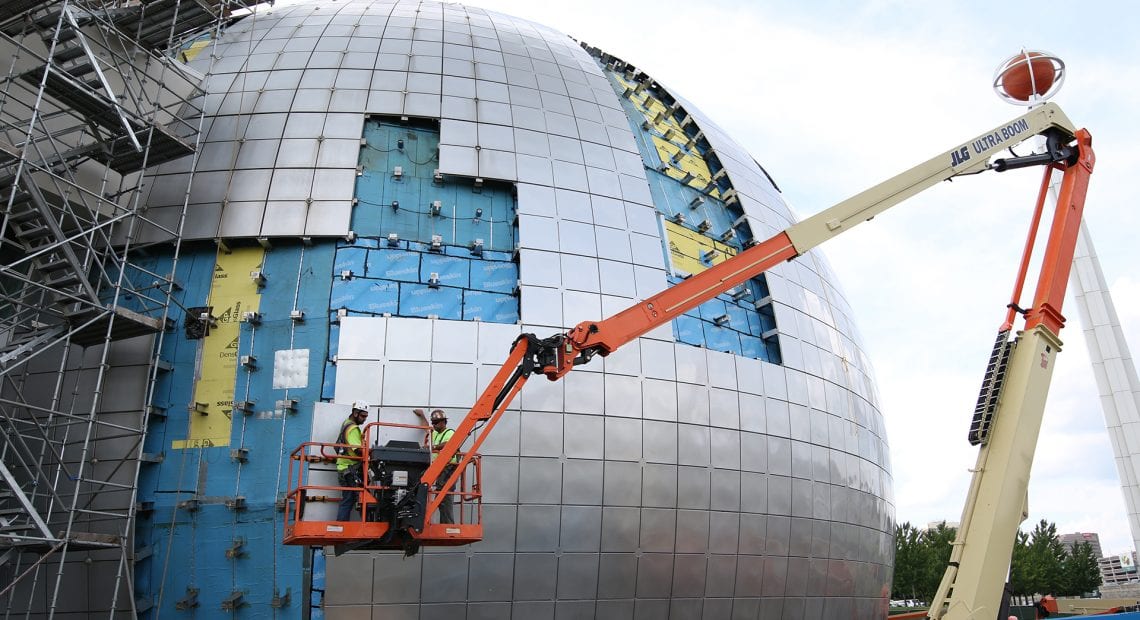
Hall of Fame Project Is a Shining Example of Teamwork, Coordination
Sphere of Influence
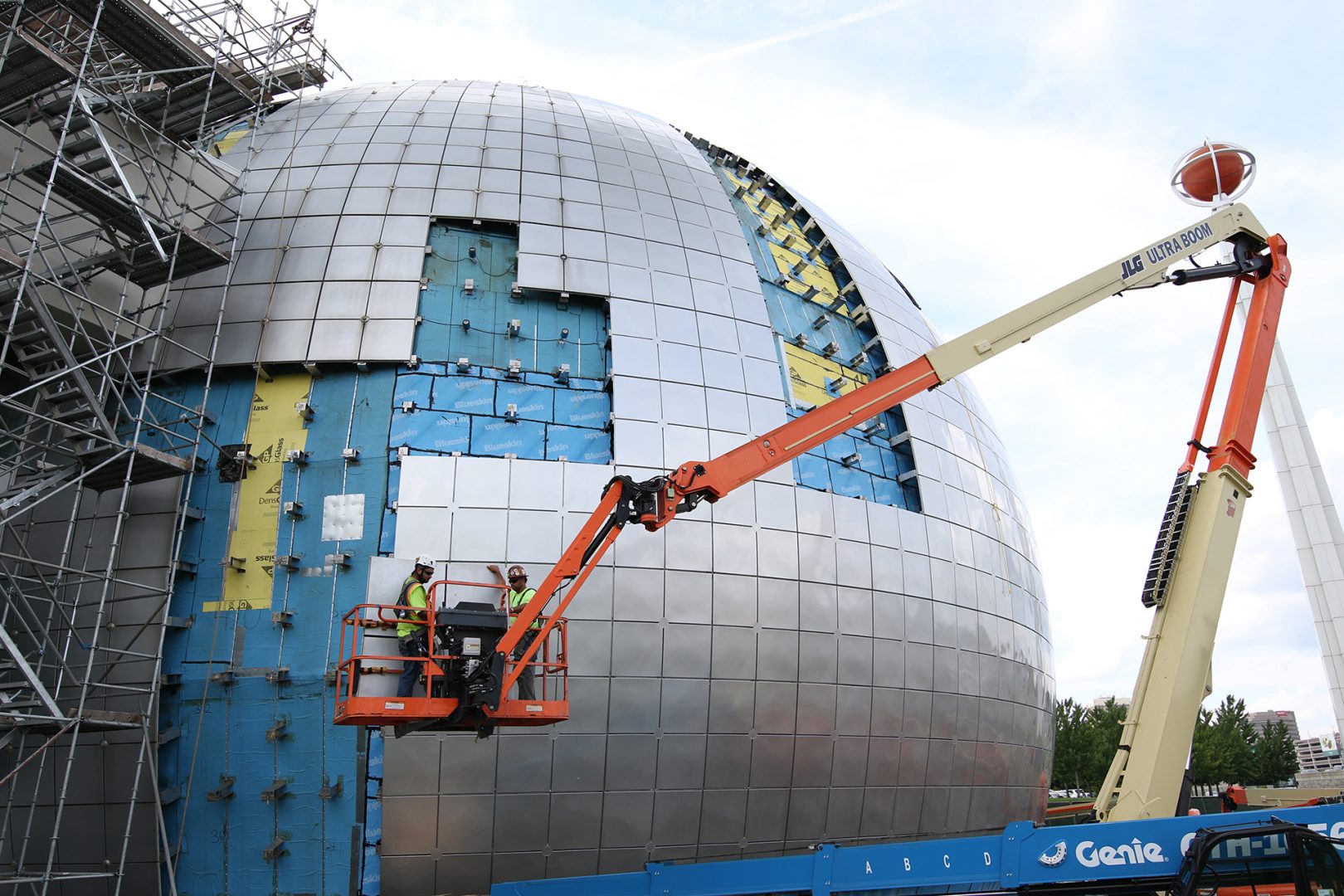 Work continues on an intriguing and highly visible project to put a fresh, more watertight face on the sphere at the Basketball Hall of Fame. The project is a study in efficient teamwork and bringing intricate work to a polished finish — quite literally.
Work continues on an intriguing and highly visible project to put a fresh, more watertight face on the sphere at the Basketball Hall of Fame. The project is a study in efficient teamwork and bringing intricate work to a polished finish — quite literally.
While the Campanile and the larger Court Square complex are perhaps the most recognizable landmarks in Springfield, the large sphere that encompasses the museum at the Basketball Hall of Fame has certainly joined that list.
And right now, that sphere has taken on the look of a giant jigsaw puzzle — with some pieces in place and many still missing — which, in many respects, is exactly what it is.
Indeed, the Hall of Fame is in the midst of a $4 million project to repair the outside of the dome, easily the most visible component of a larger project will modernize the Hall and make it far more user-friendly.
The dome work, which began in March, has become somewhat of a spectator sport because of the Hall’s high degree of visibility, especially from I-91 and even the MGM Springfield parking garage. What people can see is dramatic change between what would be considered the old and the new, even though the 900 panels that make up the sphere are not actually being replaced.
What people can’t see, though, is how intricate and challenging this reconstruction project is, and the high level of choreography involved as crews attempt to make a museum façade comprised of nearly 1,000 panels look like one very shiny globe.
Paul Dowd, president of Bloomfield, Conn.-based Managed Air Systems LLC, which is leading the initiative, explained that “what makes it unique is there are not many spherical buildings out there. This replication of a basketball is a unique structure in and of itself.”
“It didn’t give us the opportunity to really reflect all the content that’s out there, whether it was a long-time-ago hall of famer or an honoree just enshrined last year; we weren’t able to really bring them alive. The objective in our new Hall of Honor will be to provide as much information as we possibly can on all the hall of famers, no matter what era they came in, and have it be much more engaging.”
Elaborating, he said that, again, like a jigsaw puzzle, no two pieces of this dome are exactly the same, despite how things look to the naked eye and even the photographs on these pages. This means each panel must be marked when it is taken down in order to ensure that it is put in the same place when it is returned.
After they’re removed and marked, 10 pieces at a time are shipped to Managed Air Systems where they are sanded and painted — a process that takes several hours per panel.
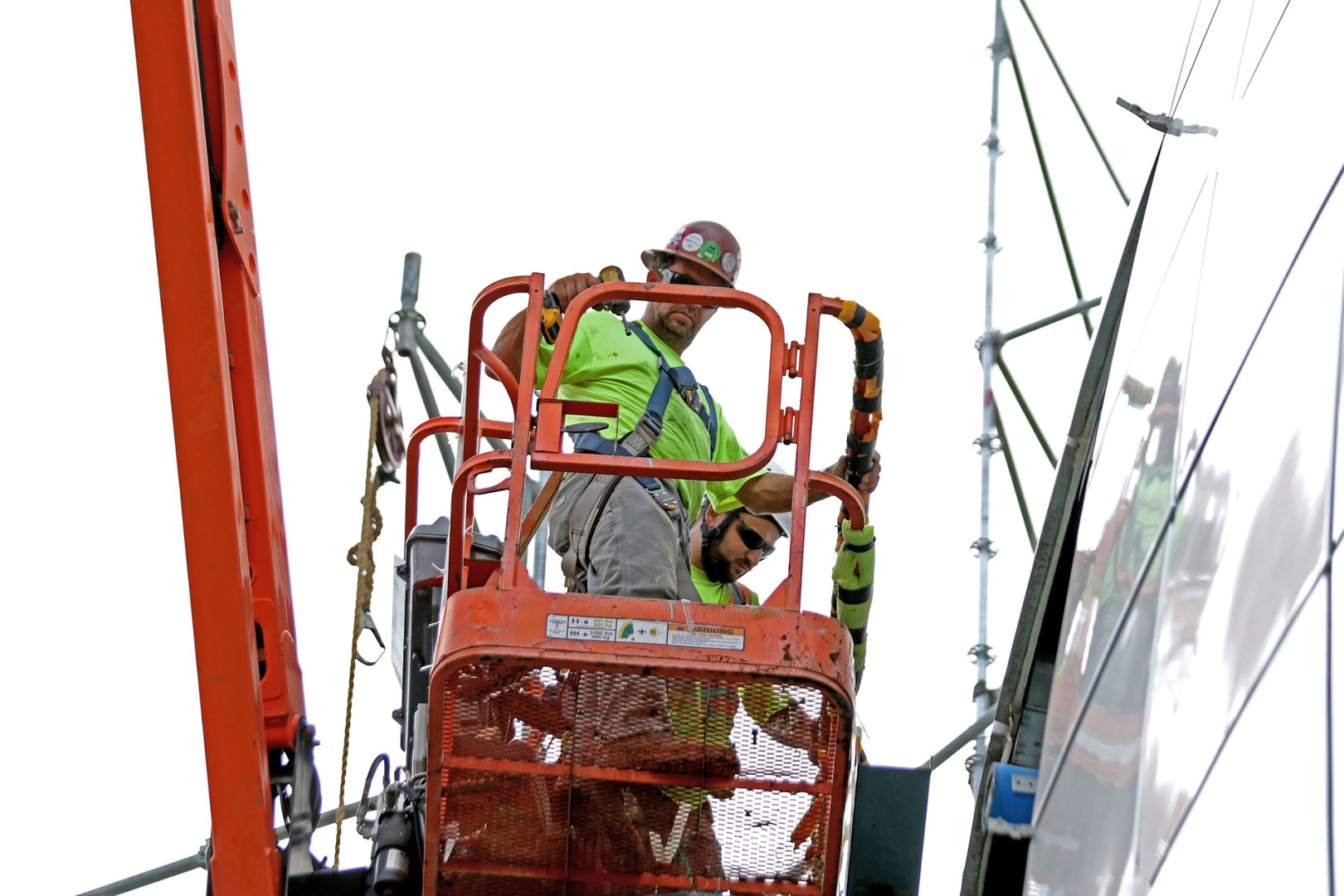
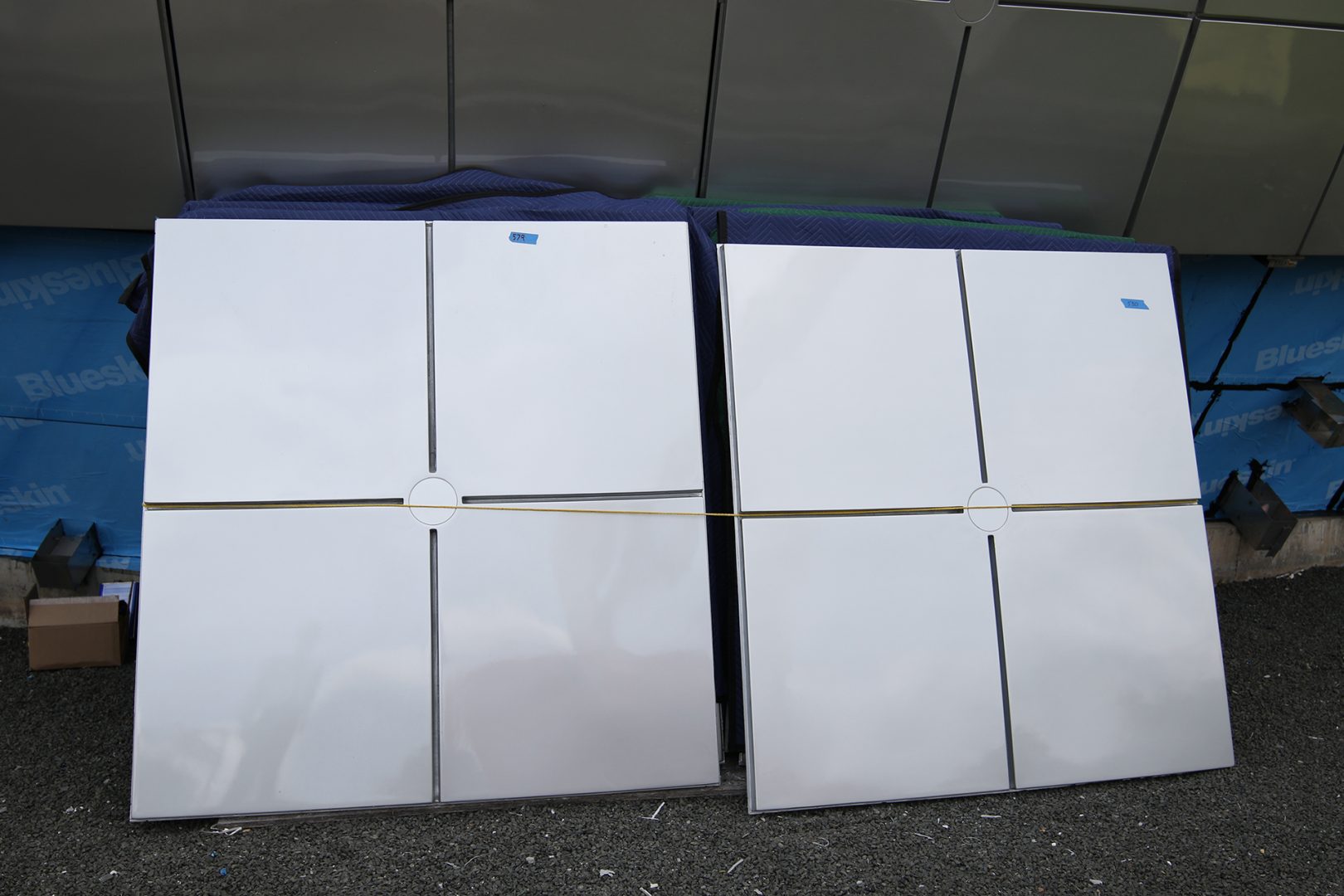
Each panel is unique and must be marked before being taken off, repaired, and put in the exact same spot it came from.
Although his firm specializes in this kind of work — Managed Air applies protective or decorative coating to anything that needs it, from cars to planes to furniture — the Hall project is somewhat different in that requires a focus on timeliness and ensuring an ultra-high level of consistency across 900 individual panels weighing 110 pounds each.
“One of the big concerns going into this was having a coordinated effort from the people taking the panels off to the people doing the rubber membrane repair on the inside to us getting the panels repaired and back to them,” said Dowd. “It was a very large, coordinated effort to make this all go smoothly.”
For this issue and its focus on construction, BusinessWest takes an in-depth, up-close look at the Hall project and how it is a shining example, figuratively but also quite literally, of effective teamwork in construction — and reconstruction.
Round Numbers
By now, a good number of people across the region have seen John Doleva, president and CEO of the Hall of Fame, hold up and talk about what he affectionately refers to as a ‘spaceship.’
That’s his pet term for the individual lights that were affixed to the museum dome as it was constructed nearly 20 years ago — the lights that took on different colors for various occasions.
He calls them ‘spaceships’ because, well, they take on the 1950s-ish, sci-fi shape of a UFO.
There are — or were — 900 of these lights — one for each panel — and roughly half of them leaked, said Doleva, adding that the damage caused by these leaks inspired the $4 million reconstruction project which will restore the panels to the original luster and replace the spaceships with LED lighting.
The project commenced in the spring, and, as both Dowd and Doleva noted, it’s been an intriguing project that requires a high level of coordination among Managed Air Systems and a host of local contractors.

John Doleva says the $4 million dome reconstruction should be finished by the end of September.
That list includes Western Builders of Granby, Chandler Architectural Products Inc. of Springfield, Kent Brothers Excavating of Southampton, Superior Caulking & Waterproofing of Palmer, Collins Electric of Chicopee, Healey & Associates of Belchertown, and project management by Colebrook Realty Services of Springfield and Holyoke.
“That was a key element as we chose vendors,” said Doleva. “We wanted them to be qualified, but there are plenty of qualified vendors in our area, and we wanted to make sure that we were employing people from our region.”
Managed Air Systems spends about 10 hours, on average, refurbishing each of the panels. Some have been damaged over the years and need additional repairs, meaning they need to be kept overnight. Once the repair and reconditioning work is done, the panels are painted to give the dome a fresh, new look.
Doleva said construction is moving quickly, so when these panels aren’t quite ready to be placed back in their positions, they are stored in the garage located under the Hall of Fame.
Dowd said the board at Hoop Hall chose a high-gloss finish for the panels, which will provide long-term durability against UV rays and weather.
“It almost looks wet when you look at the panel, very similar to a freshly painted car part,” he explained. “That glossy finish helps protect it more long-term from the exposure to the sun and the elements.”
But there’s more to it than slapping some paint on. There are three different materials that go on the panels — a sealer that allows the paint to go on, a grey metallic coating, and a clear coat that encapsulates and seals the panel. Dowd says each panel is painted in a downdraft-heated paint booth that he compares to a giant convection oven. Once the panels are painted in the booth, the press of a button cures the panels at up to 200 degrees.
Perhaps the most intricate part of this process is making sure each panel looks the same as the rest, even though they are all slightly different sizes.
“From our end, the biggest challenge we have is to have the repeatability in the quality of finish,” Dowd said, adding that the company has had to redo some panels that weren’t quite right. “You want this globe, when it’s all done, if someone was to walk around it, to have the same luster and shine and quality on it to look consistent as if it was just one giant globe.”
Once the dome is finished, LED projection lighting will be installed to light the front of the building.
“I think it will attract a lot of attention,” Dowd said. “You can’t miss it when you drive on 91 — it should get some ‘wow’ factor.”
The Bigger Picture
That phrase ‘wow factor’ applies to the many other components of the Hall renovation project as well, said Doleva.
These include the new Hall of Honor, which recently opened. It allows visitors to view any hall of famer in a brand-new, digital manner.
“It didn’t give us the opportunity to really reflect all the content that’s out there, whether it was a long-time-ago hall of famer or an honoree just enshrined last year; we weren’t able to really bring them alive,” said Doleva in reference to the old display. “The objective in our new Hall of Honor will be to provide as much information as we possibly can on all the hall of famers, no matter what era they came in, and have it be much more engaging.”
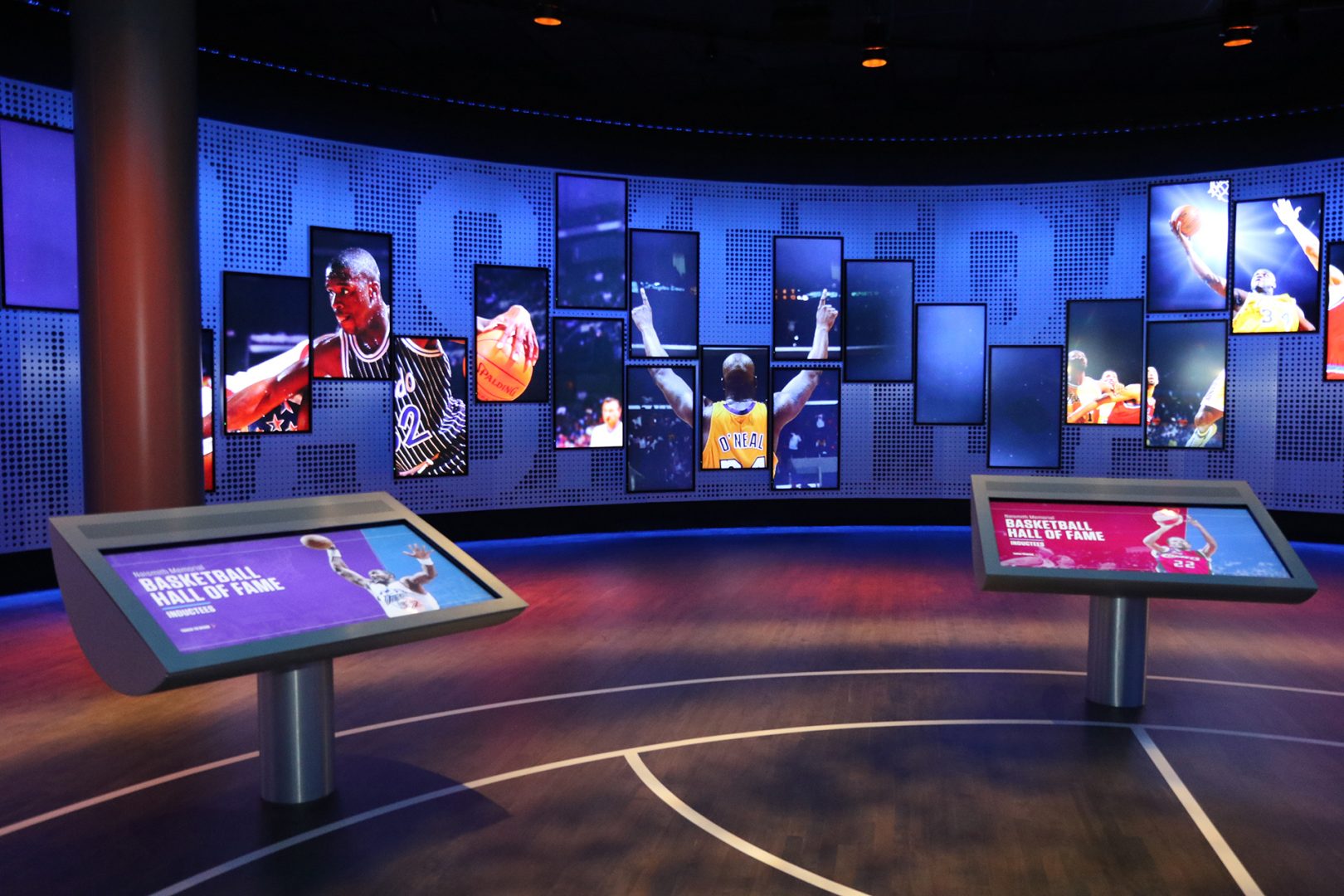
This includes the next phase of the indoor construction: a complete remodeling of the top floor of the museum. Doleva says this exhibit, sponsored by the NBA Players Assoc., will feature 16 key moments in basketball displayed in graphics on the ceiling.
“We’re going to take advantage of the verticality of that space by having a big sailboat sail of graphics and then an exhibit in front of it,” he said, adding that, while they are taking a more digital approach, they are not totally abandoning the original values of the museum, which includes physical artifacts. “What we haven’t lost sight of is what makes a sports museum different than going on your telephone and looking up sports history.”
Meanwhile, the outside of this particular sports museum will have a different look and feel as well.
The refurbished sphere will reflect a new era at the Hall — in all kinds of ways.
Kayla Ebner can be reached at [email protected]




